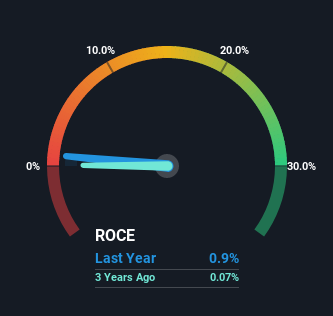- Saudi Arabia
- /
- Commercial Services
- /
- SASE:4270
The Return Trends At Saudi Printing and Packaging (TADAWUL:4270) Look Promising

To find a multi-bagger stock, what are the underlying trends we should look for in a business? Amongst other things, we'll want to see two things; firstly, a growing return on capital employed (ROCE) and secondly, an expansion in the company's amount of capital employed. Ultimately, this demonstrates that it's a business that is reinvesting profits at increasing rates of return. So when we looked at Saudi Printing and Packaging (TADAWUL:4270) and its trend of ROCE, we really liked what we saw.
Return On Capital Employed (ROCE): What Is It?
For those who don't know, ROCE is a measure of a company's yearly pre-tax profit (its return), relative to the capital employed in the business. The formula for this calculation on Saudi Printing and Packaging is:
Return on Capital Employed = Earnings Before Interest and Tax (EBIT) ÷ (Total Assets - Current Liabilities)
0.0093 = ر.س10m ÷ (ر.س1.8b - ر.س695m) (Based on the trailing twelve months to September 2022).
Therefore, Saudi Printing and Packaging has an ROCE of 0.9%. In absolute terms, that's a low return and it also under-performs the Commercial Services industry average of 8.1%.
See our latest analysis for Saudi Printing and Packaging

While the past is not representative of the future, it can be helpful to know how a company has performed historically, which is why we have this chart above. If you want to delve into the historical earnings, revenue and cash flow of Saudi Printing and Packaging, check out these free graphs here.
How Are Returns Trending?
It's great to see that Saudi Printing and Packaging has started to generate some pre-tax earnings from prior investments. Historically the company was generating losses but as we can see from the latest figures referenced above, they're now earning 0.9% on their capital employed. In regards to capital employed, Saudi Printing and Packaging is using 26% less capital than it was five years ago, which on the surface, can indicate that the business has become more efficient at generating these returns. This could potentially mean that the company is selling some of its assets.
For the record though, there was a noticeable increase in the company's current liabilities over the period, so we would attribute some of the ROCE growth to that. Essentially the business now has suppliers or short-term creditors funding about 39% of its operations, which isn't ideal. It's worth keeping an eye on this because as the percentage of current liabilities to total assets increases, some aspects of risk also increase.
The Bottom Line On Saudi Printing and Packaging's ROCE
In the end, Saudi Printing and Packaging has proven it's capital allocation skills are good with those higher returns from less amount of capital. And since the stock has fallen 15% over the last five years, there might be an opportunity here. With that in mind, we believe the promising trends warrant this stock for further investigation.
One more thing to note, we've identified 1 warning sign with Saudi Printing and Packaging and understanding this should be part of your investment process.
If you want to search for solid companies with great earnings, check out this free list of companies with good balance sheets and impressive returns on equity.
New: Manage All Your Stock Portfolios in One Place
We've created the ultimate portfolio companion for stock investors, and it's free.
• Connect an unlimited number of Portfolios and see your total in one currency
• Be alerted to new Warning Signs or Risks via email or mobile
• Track the Fair Value of your stocks
Have feedback on this article? Concerned about the content? Get in touch with us directly. Alternatively, email editorial-team (at) simplywallst.com.
This article by Simply Wall St is general in nature. We provide commentary based on historical data and analyst forecasts only using an unbiased methodology and our articles are not intended to be financial advice. It does not constitute a recommendation to buy or sell any stock, and does not take account of your objectives, or your financial situation. We aim to bring you long-term focused analysis driven by fundamental data. Note that our analysis may not factor in the latest price-sensitive company announcements or qualitative material. Simply Wall St has no position in any stocks mentioned.
About SASE:4270
Saudi Printing and Packaging
Provides printing services in the Kingdom of Saudi Arabia.
Mediocre balance sheet and slightly overvalued.
Market Insights
Community Narratives



